Epidemic diseases are those that affect large numbers of people in one area simultaneously. Pandemic is a term that refers to an epidemic that has spread to more than one area.
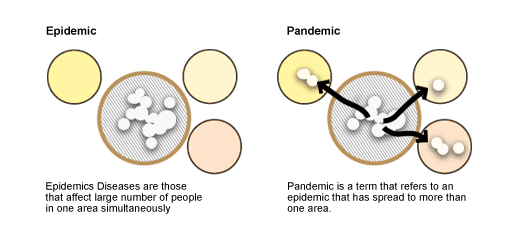
There have been a number of devastating pandemics in human history, generally those that came about with domestication of animals – such as influenza and tuberculosis. The most obvious epidemic in history has been the plagues. These are acute epidemic infectious diseases with high fatal rates. In other words, they are sudden and unexpected, spread quickly and kill lots of people each time. The best known plague is the Black Death in the 1300s.
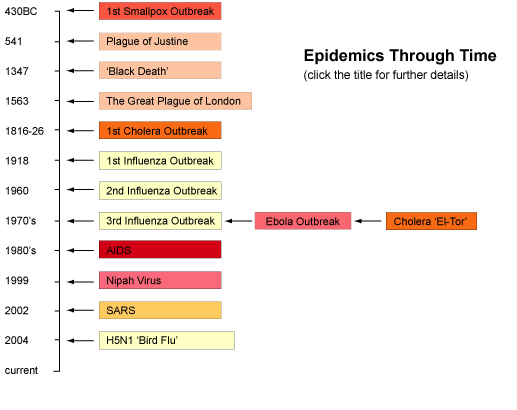
- AIDS: Most destructive pandemic in modern historyOpen or Close
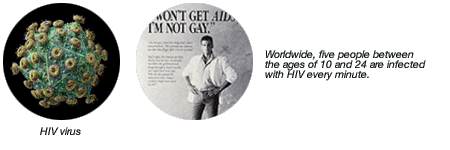
Acquired immune deficiency syndrome (AIDS) is a fatal disease that attacks the body’s immune system, making it unable to resist infection, and is caused by the human immunodeficiency virus (HIV), which is communicable in some bodily fluids and transmitted primarily through sexual behaviour and intravenous drug use.
Most researchers believe that HIV originated in sub-Saharan Africa during the twentieth Centruy. It is now a global epidemic. UNAIDS and the World Health Organization (WHO) estimate that AIDS has killed more than 25 million people since it was first discovered on December 1, 1981, making it one of the most destructive pandemics in recorded history. In 2005 alone, AIDS claimed between an estimated 2.8 and 3.6 million, of which more than 570,000 were children.
Worldwide, five people between the ages of 10 and 24 are infected with HIV every minute.
- Bubonic: The black deathOpen or Close



Bubonic plague is primarily a black disease of rodents, particularly marmots (in which the most virulent strains of plague are primarily found), but also Black Rats, prairie dogs, chipmunks, squirrels and other similar large rodents. Human infection most often occurs when a person is bitten by a rat flea (Xenopsylla cheopsis) that has fed on an infected rodent. The bacillus multiplies in the stomach of the flea. When the flea next bites a mammal, blood consumed by the flea is regurgitated along with the bacillus into the bloodstream of the bitten animal.
Globally, the World Health Organization (WHO) records a total of 1,000 to 3,000 human cases of this plague each year.
History of outbreak
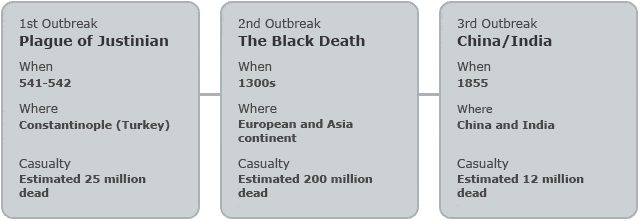
- Plague of Justinian (541)
The Plague of Justinian (541-542) is the first known pandemic recorded, and it also marks the first firmly recorded pattern of bubonic plague. This outbreak may have originated in Ethiopia or Egypt and moved northward until it reached the large city of Constantinople. (Today’s Istanbul).
At its peak, the Byzantine historian Procopius showed that the plague killed 10,000 people in Constantinople every day thus weakening the Byzantine empire. The actual number of deaths will always remained uncertain, a mystery though modern scholars believed that the plague killed up to 5,000 people per day during the pandemic. Ultimately, 40 percent of the city’s inhabitants perished. The plague went on to destroy up to a quarter of the human population of the Eastern Mediterranean. A second major plague wave in 588 spread through the Mediterranean into what is now France, causing the death of 25 million people.
- The Black Death (1347-1348)
In 1347, the plague called the Black Death infected Venice, probably carried by flea-infested rats on merchant ships bringing trade goods from Sicily.
The population of Venice dropped by almost half: from 130,000 to 70,000 by the time the outbreak ended. Following traders along the Silk Road from China through Central Asia, these rats, with their plague-carrying fleas, reached the shores of the Black Sea and on to Sicily as stowaways on Italian merchant ships.
It is estimated that the plague killed about one in every four people in its path, spreading rapidly through western Europe.
- The Great Plague of London (1563)
This plague killed three quarters (an estimate) of the population. Subsequent outbreaks, thereafter, in 1578, 1593, 1602, 1625, 1636 and 1665 killed thousands of people.
- Plague of Justinian (541)
- Cholera: A continous threatOpen or Close



Cholera (also called Asiatic Cholera) is a water-borne disease caused by the bacterium Vibrio cholerae, which is typically ingested when drinking contaminated water, or when eating improperly cooked fish, especially shellfish. Cholera was originally endemic to the Indian subcontinent, with the Ganges River likely serving as a contamination reservoir. It spread by trade routes (land and sea) to Russia, then to Western Europe, and from Europe to North America. It is now no longer considered an issue in Europe and North America, due to highly efficient filtering and chlorination of the water supply.
- First pandemic:1816-1826
Previously restricted, the pandemic began in Bengal, then spread across India by 1820. It extended as far as China and the Caspian Sea before receding.
- Second pandemic: 1829-1851
Second pandemic 1829-1851 – Second pandemic reached Europe, London and Paris in 1832. In London, it claimed at least 3,000 victims according to a 1832 article while in Paris, 20,000 from a humble population of 650 000, and 100,000 in all of France.
- Third pandemic: 1852-1860
Third pandemic mainly affected Russia, with over a million deaths.
- Fourth pandemic: 1863-1875
Fourth pandemic spread mostly in Europe and Africa.
1866 – Outbreak in North America. - Fifth pandemic: 1899-1923
Fifth pandemic had little effect in Europe because of advances in public health, but Russia was badly affected again.
- Sixth pandemic: 1961-1970s
Sixth pandemic began in Indonesia, called El Tor after the strain, and reached Bangladesh in 1963, India in 1964, and the USSR in 1966. From North Africa it spread into Italy by 1973. In the late 1970s there were small outbreaks in Japan and in the South Pacific.
anuary 1991 to September 1994 – Outbreak in South America, apparently initiated by discharged ballast water. Beginning in Peru there were 1.04 million identified cases and almost 10,000 deaths.
- First pandemic:1816-1826
- Ebola: One of the deadly virusesOpen or Close
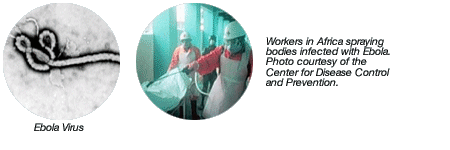
First identified as a virus-caused disease in the 1970s, Ebola is a notoriously deadly virus that causes fearsome symptoms, the most prominent being high fever and massive internal bleeding. Ebola virus kills as many as 90% of the people it infects. It is one of the viruses that is capable of causing hemorrhagic (bloody) fever.
Epidemics of Ebola virus have occurred mainly in African countries including Zaire (now the Democratic Republic of Congo), Gabon, Uganda, the Ivory Coast, and Sudan. Ebola virus is a hazard to laboratory workers and anyone who is exposed to it.
Ebola virus is an extremely contagious filovirus causing an acute, highly fatal hemorrhagic fever that spreads through contact with bodily fluids or secretions of infected persons and by airborne particles. It usually kills 9 out of 10 people it infects almost always immediately. Because there is currently no prevention or cure for the disease, the 1995 Ebola outbreak in Central Africa, during which about 800 people died, caused a widespread alarm.
Year Location No. of cases Percentage of deaths
among cases1976 Zaire
Sudan318
28488% (9 out of 10)
53% (1 out of 2)1979 Sudan 34 65% (1 out of 3) 1994 Gabon 49 59% (3 out of 5) 1995 Republic of the Congo
(formely Zaire315 81% (4 out of 5) 1996 Gabon 91 72% (7 out of 10) 2000-2001 Uganda
Gabon and Republic of the
Congo (formery Zaire)425
12253% (1 out of 2)
79% (4 out of 5)Source; CDC, Special Pathogens Branch. Last updated November 26, 2003
- Influenza: An emerging pandemicOpen or Close



Influenza, commonly known as the flu or the grippe, is a contagious disease of the upper airways and the lungs, caused by an RNA virus of the orthomyxoviridae family. It rapidly spreads around the world in seasonal epidemics, killing millions of people in pandemic years and hundreds of thousands in non-pandemic years.
Since the 16th Centruy, when accurate recording began, each Centruy has seen an average of three outbreaks of pandemic influenza, occurring at intervals from 10 to 50 years. In the 20th Century, there were three influenza pandemics:
History of outbreak
- 1st Outbreak
Previously restricted, the pandemic began in Bengal, then spread across India by 1820. It extended as far as China and the Caspian Sea before receding.
- 2nd Outbreak
1957-1958.. The outbreak began in February 1957 in China., by August 1957, around two million people were estimated to have died during the pandemic.
- 3rd Outbreak
1968-1969. The virus was thought to have emerged in China and was first detected in Hong Kong. Around one million people were thought to have died worldwide.
- Current Situation
1997-current – Influenza outbreak (Avian Flu – H5N1) in Hong Kong, China, Vietnam, Indonesia, Egypt, Europe.
The current global attention is focused the H5N1 strain in the avian influenza which was detected in pigs in Vietnam in February 2004. A new variant of the disease could be both highly contagious and highly lethal in humans. Such a subtype could cause a global influenza pandemic.
- 1st Outbreak
- Nipah virus: A new virusOpen or Close

Nipah virus was identified in 1999 when it caused an outbreak of neurological and respiratory disease on pig farms in Peninsular Malaysia, resulting in 105 human deaths and the culling of one million pigs. In Singapore, 11 cases including one death occurred in abattoir workers exposed to pigs imported from the affected Malaysian farms. Six more outbreaks of the Nipah virus have occurred since 1999, one in India and five in Bangladesh.
History of outbreak
-
From September 1998 – April 1999, there was a large outbreak of encephalitis in Malaysia. During the investigation of this outbreak, Nipah virus, a previously unrecognized virus, was identified as the causal agent. A total of 265 people were infected, of whom 105 died.
-
An associated outbreak among abattoir workers in Singapore during March 1999 led to 11 cases, with 1 death. These workers had been handling pigs that had been imported from the outbreak areas in Malaysia.
-
- Smallpox: The disease that destroyed two empiresOpen or Close


Though no longer regarded as a threat, smallpox has killed millions in the past. Smallpox is an acute, highly contagious disease causing a high fever and successive stages of severe skin eruptions. The disease dates from the time of ancient Egypt or before. It has occurred worldwide in epidemics throughout history, killing up to 40% of those who contracted it and accounting for more deaths over time than any other infectious disease. Spreading to the New World with European colonization, it killed huge numbers of the indigenous people, who had no immunity, greatly contributing to the annihilation of native cultures.
Smallpox is caused by a virus that may be airborne or through direct contact with the infected. There is no specific treatment for smallpox. An antibiotic may be administered to prevent secondary bacterial infection. After 1980, WHO officially declared that smallpox has been eradicated as a disease.
- Eurasia
- 430BC: The Plague of Athens decimated the city of Athens, killing around a third of the population, according to Thucydides.
- 165-180: The Antonine Plague swept through the Roman Empire and Italy. This was followed by a second major outbreak in the Empire, known as the Plague of Cyprian (251–266)
- The next major epidemic believed to be smallpox occurred in India. The exact date is unknown. Around 400
- The America
- 1500s: Smallpox devastated the Aztec population. It killed most of the Aztec army, the emperor, and 25% of the overall population
- 1500s: Smallpox spread rapidly in the Inca empire and within a few years smallpox claimed between 60% and 90% of the Inca population
- 1633: Plymouth, Massachusetts, the Native Americans were struck by the virus and it wiped out the entire population groups of Native Americans. It reached Lake Ontario in 1636 and the lands of the Iroquois by 1679, killing millions.
- 1636-1698: 6 outbreaks occurred in Boston
- 1721: Boston, The entire population fled the city, bringing the virus to the rest of the 13 colonies.
- Late 1770s: During the American Revolutionary War, smallpox returned once more and killed an estimated 125,000 people
- Eurasia
- SARS: The 21st century’s global epidemicOpen or Close


Severe Acute Respiratory Syndrome — or SARS — is a mysterious virus that swept across parts of Asia and the Far East, and moved worldwide. It is thought that the virus originated in the Guangdong province in southern China, with neighbouring Hong Kong being one of the main centers of the outbreak.. The spread of the disease prompted Singapore and Hong Kong and parts of Canada to close certain public places and invoke a quarantine law affecting people thought to have had close contact with others who were infected with the disease.
The disease apparently first occurred in November 2002, in Foshan, of the Guangdong province, China and subsequently spread to 30 other countries on five continents, and affected the economies of China, Hong Kong, and Toronto, where cases were the highest. Taiwan and Singapore were also drastically affected. The rapid international spreads of the 2002/03 outbreaks were partly facilitated by air travel.
Outbreak history
- November 2002: First case reported in China
- Feb 2003: 305 cases reported in China with 5 deaths
- March 2003: Cases reported in Hong Kong, Hanoi, Singapore, Toronto and China
- May 2003. More than 200 new cases were reported daily. By July 11, 2003 there were 8,437 total patients and 813 of them had died.
- SARS cases were identified in 29 countries, though in most countries, cases were imported. The only areas that experienced local transmission of SARS were mainland China; Beijing; Hong Kong; Taiwan; Hanoi, Vietnam; Toronto, Canada; and Singapore.
- April 2004, SARS was confirmed in 9 patients in China. One died
- The global outbreak had been contained by July 2003, but SARS has since reappeared in isolated incidents related to laboratory accidents. The first occurred in Singapore in September 2003, when a researcher contracted SARS from his laboratory. The second case was reported in Taiwan in December 2003. Again, a research worker who was handling the SARS virus became infected
For more information:
http://www.cdc.gov/ncidod/sars/
